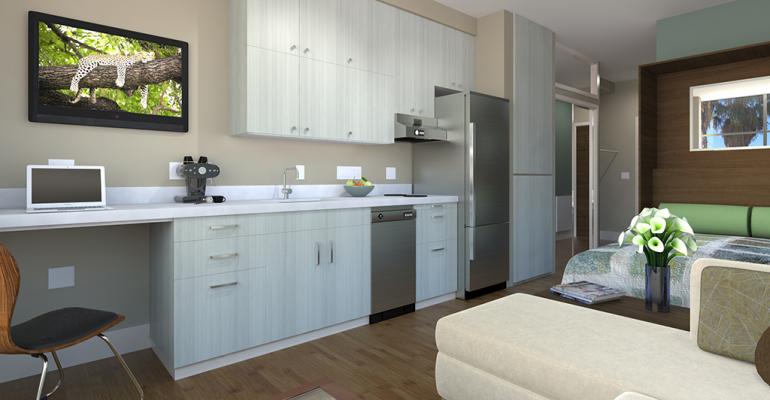Housing advocates and innovative developers are finding new ways to provide housing in some of the nation’s most expensive apartment markets.
For example, Stage 3 Properties, based in New York City, provides micro-apartments and generous shared amenity spaces in high-end multifamily properties, in places like the city’s expensive Long Island City neighborhood. According to research from residential real estate brokerage MNS, in February the average rent for a Long Island City one-bedroom totaled $2,788 a month.
Stage 3 carefully navigates New York City’s complicated, changing web of apartment regulations to provide these smaller units, according to local housing advocates. However, not every shared housing provider seems to be following the rules. A few seem to simply be going forward with projects that provide shared housing, seemingly in defiance of the rules.
“I hope this can flourish in a safe an legal way,” says Sarah Watson, deputy director for the Citizens Housing and Planning Council New York, a non-partisan research organization that focuses on housing and economic development.
Outdated rules
Shared living is already common in apartment markets across the country. Apartments and single-family houses have been turned into improvised dormitories or roughly subdivided, often for low wage workers.
However, in most parts of the country it’s illegal to create new buildings that include micro-apartments or shared housing units. New York City regulations have effectively made it impossible to build individual apartments with less than 400 sq. ft. of space apiece. Single room occupancy properties, with shared kitchens and bathrooms, are also illegal. Another New York City rule does not allow more than three unrelated people to live together in a single housing unit.
Those rules are changing. New York City now sometimes allows the creation of micro apartments in certain situations. Stage 3 Properties offers apartments as small as 265 sq. ft. (renting for $2,650 a month, with WiFi, furniture and housekeeping, at its Carmel Place community). New York City’s density rules don’t allow too many of these small units concentrated together, so Stage 3 mixes micro units with larger suites of two- and three-bedroom apartments and sometimes partners with existing apartment developers to scatter its small units and shared spaces in larger apartment communities.
Other shared housing providers do not follow the rules. “Many new shared housing providers are not doing it legally,” says Watson. “I’m not sure how they are getting away with it.”
This spring Common, based in New York City, will open its first ground-up shared housing development in the hip Williamsburg neighborhood of Brooklyn. The company already has two shared housing communities operating in older Brooklyn buildings. Each bedroom at its Havemeyer property is reserved for a single person or a couple; the rest of the spaces are shared. Havermeyer’s 51 bedrooms are grouped into 12 “suites,” which seem to be akin to individual apartments—so the project would not be categorized as an illegal single room occupancy building. That works out to an average of more than four bedrooms per suite, so it is not clear how Havemeyer complies with New York City’s rule that no more than three unrelated people can live together in any one apartment.
Housing advocates worry that defying local housing regulations could poison the discussion as they work with local officials to provide more housing choices for growing cities like New York. If shared living properties get a reputation, for example, for bending fire safety regulations, legislators could take a tougher view on these projects.
“It creates an opposition,” says Watson. “It does make the conversation a little harder.”
Many of the country’s apartment markets clearly needs something like shared housing, however, as rents get increasingly expensive. “The informal market is showing the demand—they are filling a gap in the market that everyone can see,” says Watson.

